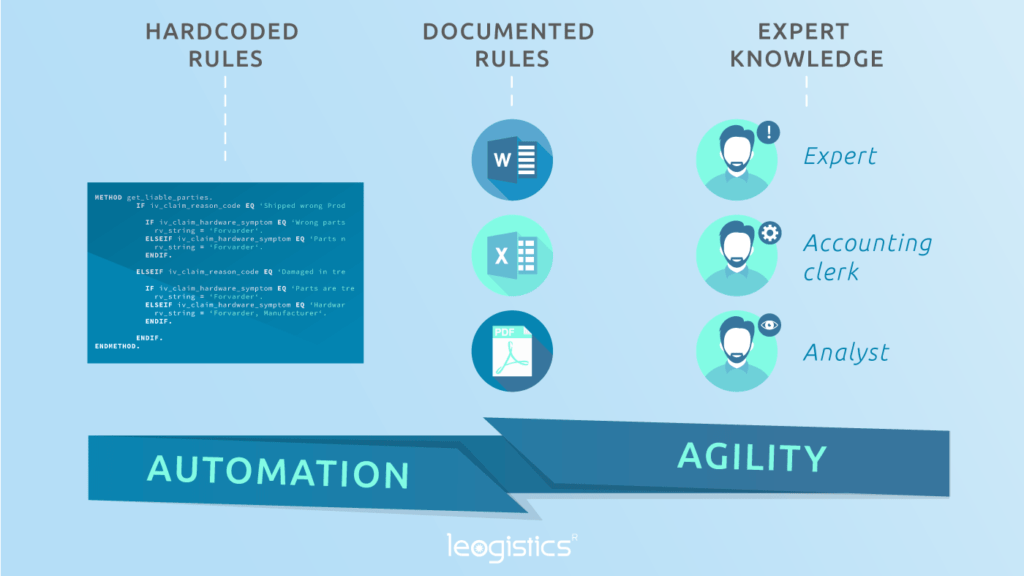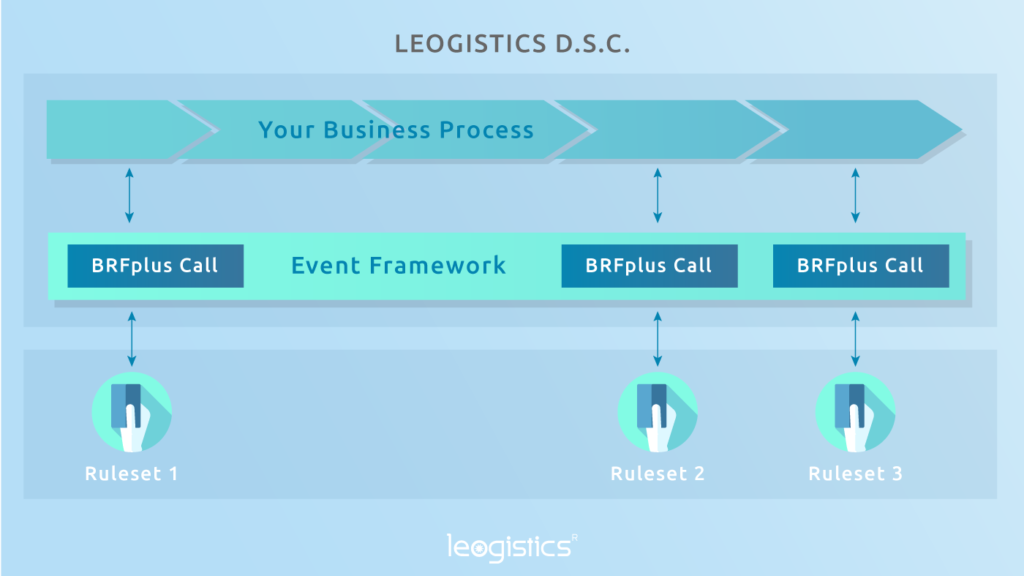The use of complex sets of rules in scm projects
Our private and professional everyday life is influenced by decisions. We often encounter the following questions: Which freight forwarder should I choose, the cheapest or the most reliable? Where should I store my goods temporarily, in the warehouse or near the dispatch area?
Carefully set up rules and regulations can be a sound basis for decision-making in order to automate processes as far as possible and to focus on exceptional situations. They also increase the reusability of applications or functions if the input variable is processed differently depending on the intended use.
“A Business Rule Management System is a critical piece of software infrastructure that no modern IT organization should be without.“
– James Taylor (Founder and CEO of Decision Management Solutions)
This article explains the relevance of Taylor’s statement from 2012 to the present and what actions are needed to make it relevant for your business and software solutions.
Where do we encounter business principles in logistics?
There are countless business regulations that control and influence the process even in a simple scenario of truck yard control.
| Which truck may enter the plant next for loading/unloading | Rules for prioritizing the waiting trucks for dispatch to the plant or loading point. |
| Which documents need to be printed? | Rules for printing documents depending on the scenario in question (for example, transport of dangerous goods or export transactions). |
| What is the next station for the truck - unloading point for bulk goods, another waiting area for a detailed call-off? | Rules for the routing of trucks on the yard. |
| When should which process participant (e.g. driver, dispatcher, freight forwarder) automatically receive a message and what information should it contain? | Rules for alerts and notifications that are to be sent. |
Automatization versus agility
The implementation of such rules is difficult and the two goals “automation” and “agility” can be in conflict with each other. Often rules are hard-coded in the code of the IT solution so that they are performed automatically. The other extreme is the implementation of the rules as tactical knowledge in the heads of the employees.
In this case, the dispatcher knows from experience and learned rules which truck to call next into the plant. This makes it easy to change and expand, whereas programmed rules usually cannot be changed without major effort and with the involvement of the IT organization. A compromise is represented by documented rules, which on the one hand can be changed quickly and on the other hand offer a certain automation.

The importance of business rule management systems
A BRMS is a purpose-built IT system for creating, managing and executing rules. It enables business rules to be separated from business processes.

This means that the rules are no longer embedded in the program code of individual applications, but in a separate system. They can be called from the programs and processes.
This separation of business rules from the rest of the logic and code of other applications offers companies many advantages:
- Volatile business rules can be modified with flexibility and by the business departments themselves. Neither the business processes nor the program code needs to be changed.
- The rules can be called up and executed automatically.
- Using a BRMS, particularly complex business rules can be modeled.
- The business rules are stored and managed centrally. This provides consistency, control options, and transparency.
Implementation of business rules with brfplus
Business Rules Framework plus (BRFplus) is a BRMS solution from SAP and has been available as part of SAP NetWeaver 7.0 since 2008. BRFplus can therefore theoretically be used by any SAP application. The call is usually made from the relevant program code.
Using BRFplus instead of other BRMS has the advantage for SAP customers that there are no additional hardware costs for servers or license fees. Furthermore, no additional interfaces to the SAP applications have to be created, and administration can also be covered by the administration of the entire SAP system.
What possibilities does BRFplus offer?
BRFplus offers extensive functionality for modeling, managing and executing business rules. In so-called functions and rule sets, the business rules can be implemented using various expressions and actions. These include, among others:
- Decision tables
- Formulas
- Table operations
- Decision trees
- Search trees
- Loops
- Function calls
- Procedure calls
SAP uses the potential of BRFplus, for example, in SAP Transportation Management, which enables a large number of predefined jumps to customer specific BRFplus rules. Furthermore, BRFplus can now also be used for pricing in SAP ERP, and in S/4HANA, message processing is also converted to BRFplus.
Integration of brfplus into leogistics dsc
On our customers’ yards thousands of statuses are set daily, activities are started and logged, and resources are moved back and forth between locations. These operations map the business processes in the system and are planned, executed and maintained in leogistics d.s.c. The business rules that significantly influence the process are not implemented in the program code, which would make them cumbersome to change. Jumps to BRFplus have been predefined to implement customer-specific sets of rules using simple decision tables (for example, to determine target locations for the movement of resources in the yard).
You can jump to a BRFplus set of rules flexibly and event controlled. No programming is required for this and you can run through not only simple decision tables but also complex sets of rules.

Case examples: Where do we apply BRFplus?
Thus it is possible to configure the following example without further programming:
- Modeling a BRFplus function for calculating an expected utilization of a truck.
- Setting an event for calling the BRFplus function.
- Trigger: Add or remove charge.
- As input, cargo and freight carrier information is passed to the function.
- As output the workload is returned.
The set of rules can also be changed later without programming or called up at another time with another trigger (for example when changing the load carrier type)
In the leogistics d.s.c. TRUCK Solution, this functionality is used for many other scenarios in which customer-specific rules and requirements influence the business process, for example:
- During the calculation of waiting points of a truck for the call-off to the plant or
- For the determination of controlling process indicators.
More flexibility with BRMS
Thus, the new integration level of leogistics d.s.c. with SAP BRFplus enables a flexible separation of customer-specific business rules from program code and business processes in accordance with the BRMS approach. The goals of “agility” and “automation” can both be achieved and your Logistics Execution Management system can thus be taken to the next level.
Although BRFplus has been available for quite some time, the solution is still unknown in many companies and the full potential of the solution is rarely exploited. You want to use BRFplus to map your business processes? Then please contact us!
If you have questions about this or other topics in the blog, please contact blog@leogistics.com.
Niklas Schützler
Senior Consultant SAP Logistics




